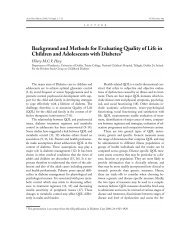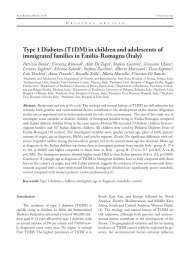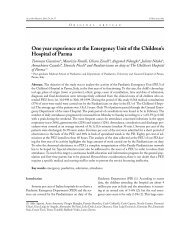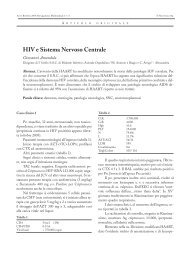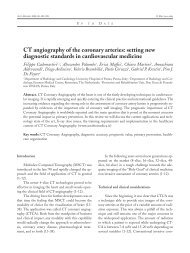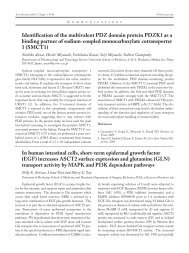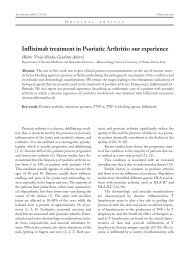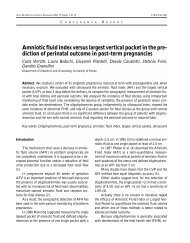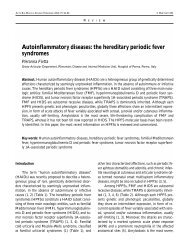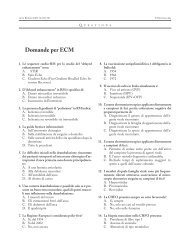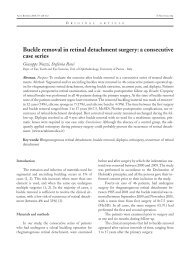Short reports+frontesp96-98 - Acta Bio Medica Atenei Parmensis
Short reports+frontesp96-98 - Acta Bio Medica Atenei Parmensis
Short reports+frontesp96-98 - Acta Bio Medica Atenei Parmensis
Create successful ePaper yourself
Turn your PDF publications into a flip-book with our unique Google optimized e-Paper software.
108 <strong>Short</strong> Reports<br />
tection system were deployd in the distal internal carotid<br />
artery before the the stent delivery in all patients.<br />
In each patient neurologic examination was performed<br />
(including the NIH stroke scale) before and after<br />
the procedure. All patient were followed by ultrasound<br />
study in the follow-up. Results: There was no operative<br />
mortality and no major stroke in the series. Two patients<br />
(11,1 %) suffered transiet ischemic attack after<br />
the procedure. The mean follow-up time has been 11<br />
months and no evidence of recurrent stenosis has been<br />
reportes. Conclusion: The benefit of CEA were mainly<br />
achieved by carefully selecting patients, excluding elderly<br />
patients (older than 79 y.o.) and those at high risk<br />
for concomitant medical conditions. CAS is evolving<br />
as an alternative to carotid endoarterectomy because<br />
it’s less invasive and does not have the risk of<br />
anesthesia. A major limitation of carotid angioplasty is<br />
distal embolization during the procedure: baloon dilatation,<br />
stent implantation and manipulation of the<br />
vessel through catheters and wires release embolic debris,<br />
wich can cause severe damage. Therefore embolic<br />
protection devices have to be routinely applied to<br />
emphasize the advantage of this less invasive procedure.Nevertheless<br />
we had two neurological transiet complication<br />
in the first period of the experience, probably<br />
related to the learning curve. In-stent recurrent stenosis<br />
after carotid artery stenting has been reported as a<br />
relatively infrequent complication (3.5-4.9%) and up<br />
to now we didn’t observe anyone.<br />
Day Surgery for the treatment of inguinal<br />
hernia: our experience<br />
G.S. Gidaro, A. Bisconti, L. Bonomo, S. Gidaro, F. Marino,<br />
G. Dragani<br />
I Department of General Surgical Unit, University of Chieti-<br />
Pescara “G. D’Annunzio”, Italy<br />
Objective: Inguinal hernia in an important and<br />
frequent problem in old patients. The aim of this<br />
study is to have a complete review of our cases and to<br />
evaluate the utility of Day Surgery (DS) in this patology.<br />
Materials and methods: Between January 1994 to<br />
June 2005 we treated 342 patients with inguinal and<br />
femoral hernia (313 males and 29 females), 302 with<br />
inguinal hernia (16 bilateral) and 40 with femoral hernia.<br />
Mean age was 77.2 years (range 70-99). General<br />
anaesthesia was performed in 55 cases; the other patients<br />
underwent loco-regional anaesthesia. In 77 cases<br />
were incarcerated and strangulated hernias; bowel<br />
resection was performed in 13 cases; 216 surgical procedure<br />
were done using Tendion Free technique. Preoperative<br />
management of DS patients consisted of<br />
blood examination, ECG, chest x-ray and in particular<br />
cases cardiological and anaesthesiological evaluation.<br />
Result: All this DS patients arrived to our Center<br />
only a few hours before surgery and underwent trichotomy.<br />
A singol dose of antibiotics was subministrered.<br />
Before surgery, skin was washed with povidone<br />
iodium. Two percent carbocaine was used for locoregional<br />
anaesthesia. In the post-operative period the<br />
attention was focused on pain controll and diuresis.<br />
All the patients left hospital approximatively 4 hours<br />
sfter operation. On the hother side, the patients who<br />
underwent general anaesthesia had a medium postoperative<br />
recovery of 4.6 days. Mortality rate was<br />
0.74% (3 inguinal and 2 femoral incarcerated hernias).<br />
There were not significant local complications. Recurrence<br />
rate was 2.15% (4 cases treated with traditional<br />
technique). No recurrence occurred in patients treated<br />
with tension-free technique. Conclusion: In the old patients<br />
with inguinal or femoral hernia we prefer to use<br />
tension-free technique because it’s a safe and simple<br />
procedure, without significant complications and low<br />
recurrence rate. Moreover DS and local anaesthesia<br />
are optimal solution for these old patients that often<br />
have associated disease (diabetes, hypertension), there<br />
was also good compliance in pain control with lower<br />
post-operative analgesic therapy.<br />
Surgical aspect in the treatment of differentiated<br />
thyroid cancer in the elderly<br />
S. Gili, R. Ruggiero, E. Procaccini, G. Docimo, R. De<br />
Luca, F. Lo Schiavo<br />
III Division of General Surgical Unit, II University of Naples,<br />
Naples, Italy<br />
Introduction: Thyroid carcinoma, despite accounting<br />
for 1% of all human cancer, are the most common<br />
endocrine malignancy. Papillary carcinoma has an excellent<br />
long-term prognosis, the overall survival rate at



